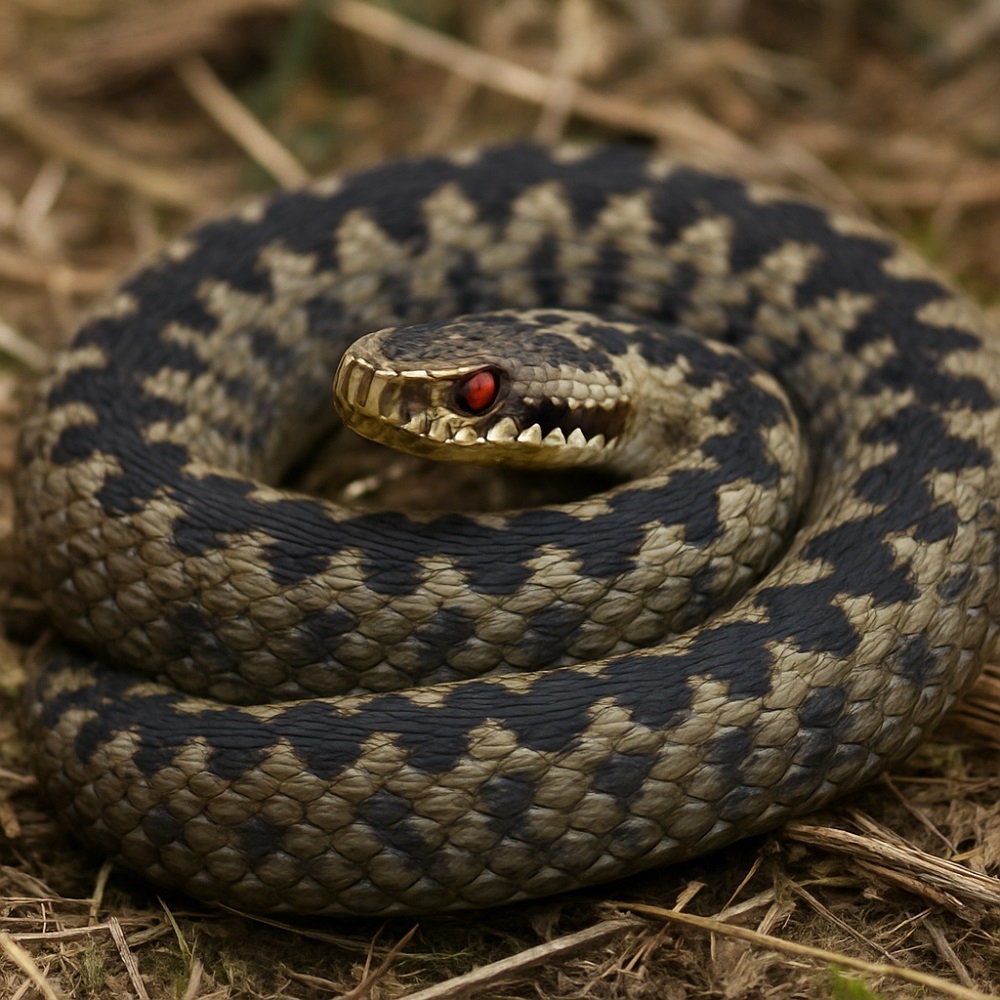Adder Bites and What They Mean For Your Gundog
Adder Awareness: Protecting Your Gundog from the UK's Only Venomous Snake
Spring and summer sunshine beckons us and our gundogs outdoors. The same warm weather that we enjoy exploring heathlands, woodlands, and coastal paths also brings out the UK's only native venomous snake – the European Adder (Vipera berus). While generally shy, adders can bite defensively if disturbed, posing a serious, potentially life-threatening risk to inquisitive dogs.

Knowing how to recognise an adder, understand the risks, take preventative measures, and act swiftly in an emergency is vital for every gundog owner.
Understanding the Adder
The adder is relatively small (rarely exceeding 60-70cm) and stocky. While colour varies, they typically have a distinct dark zigzag pattern down their back, often on a grey (male) or light brown/reddish (female) background. They also have a 'V' or 'X' shaped marking on the back of their head and pupils that are vertical slits (like a cat's).They favour habitats like:
- Heathland and moorland
- Woodland edges and clearings
- Coastal dunes and paths
- Rough grassland
An adder bite should ALWAYS be treated as a veterinary emergency.
The venom can cause severe pain, swelling, and systemic effects. Time is critical.
Look out for these symptoms, which often appear rapidly (within minutes to a couple of hours):
- Severe, rapid swelling: Usually localised around the bite area (often face or legs).
- Pain: The dog may yelp, whine, seem anxious, or be reluctant to be touched near the bite.
- Puncture Wounds: Two small puncture marks may be visible (though often hidden by fur or swelling).
- Lethargy/Weakness/Collapse: The dog may become very tired, wobbly, or unable to stand.
- Pale Gums: Indicating shock.
- Drooling, Vomiting, or Diarrhoea.
- Panting or Rapid Breathing.
- Trembling.
Often, the first sign is the dog yelping and jumping back, followed quickly by the onset of severe swelling and pain around the bite site, typically on the muzzle, head, neck, or lower limbs where dogs investigate scents or disturb basking snakes. Even if you don't see the snake or obvious puncture wounds, the sudden onset of severe swelling and pain warrants immediate suspicion of an adder bite.
Immediate Action: What TO Do If You Suspect a BiteActing quickly and correctly can significantly improve your dog's prognosis.
- Call Your Vet IMMEDIATELY: This is the most crucial step. Inform them you suspect an adder bite and are on your way. This allows them to prepare for your arrival (e.g., getting antivenom ready if needed).
- Minimise ALL Movement: Keep your dog as still as possible. Movement increases blood flow and can speed up the spread of venom around the body. Carry the dog if feasible (especially smaller breeds). If you must walk a larger dog, do so very slowly and only as far as necessary to get to transport.
- Keep the Dog Calm and Quiet: Reassure your dog gently. Stress can also increase heart rate and venom spread.
- Go Straight to the Vet: Do not delay. Drive carefully but quickly to the nearest veterinary practice.
Outdated advice or myths can be dangerous and waste precious time.
- DO NOT Apply a Tourniquet: This cuts off blood supply and can cause severe tissue damage, potentially leading to limb loss, without effectively stopping venom spread.
- DO NOT Try to Cut or Lance the Wound: This increases tissue damage and infection risk and doesn't help.
- DO NOT Try to Suck Out the Venom: This is ineffective and could introduce infection (or even risk venom exposure for the person).
- DO NOT Give Human Medications: Painkillers like aspirin or ibuprofen can interfere with blood clotting and cause other complications. Let the vet administer appropriate medication.
- DO NOT Delay Seeking Veterinary Help: Do not 'wait and see'. Prompt treatment is essential.
While eliminating the risk entirely is difficult when working dogs in the countryside, you can take steps to reduce the chances of an encounter:
- Know Adder Habitats: Be aware of areas where adders are commonly found, especially during warmer months (March-October).
- Keep Dogs Close: In high-risk areas, consider keeping your dog on a lead or walking close to heel, especially on warm, sunny days. Stick to main paths where vegetation is shorter.
- Make Noise: Snakes often rely on vibration to detect approach. Walking heavily or talking can sometimes encourage them to move away before you get too close.
- Train Commands: A strong 'leave it' or recall command can help pull your dog away from investigating something suspicious.
- Be Vigilant: Pay attention to where your dog is exploring, especially near patches of dense undergrowth or sunny banks.
Once at the vet, treatment will focus on counteracting shock, reducing swelling and pain, and neutralising the venom. This may involve:
- Intravenous fluids (a drip)
- Strong pain relief
- Anti-inflammatory medication
- Close monitoring of vital signs
- Antivenom: This is the specific antidote to adder venom. Its use depends on the severity of the bite, the dog's condition, and availability. It can be highly effective but also carries potential risks and costs, which your vet will discuss.
Conclusion
Adders are a protected species and part of our natural heritage. While the risk of a bite is relatively low, the consequences for a gundog can be severe. Being aware of the danger, knowing the signs, and understanding the absolute necessity of immediate veterinary intervention are key. Stay vigilant, especially during the warmer months, keep your vet's number handy, and take sensible precautions to help keep your hardworking companion safe while enjoying the British countryside.
